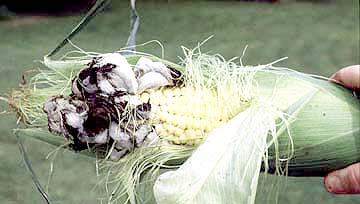Corn Smut

Photo Courtesy of:
http://www.ppdl.purdue.edu/ppdl/expert/Corn_Smut.html
Last updated by
Nick Dolezal
on February 5, 2002
Common Names of Corn Smut:
-Smut
-Common Smut
Causal Agent:
Species:
Ustilago maydis
Class:
Fungi
Order:
Basidiomycetes
Host Range:
Here are some of the alternate crops, ornamentals, and weeds that Corn
Smut can survive on:
|
|
|
|
|
|
|
|
|
|
Geographical Range:
Corn Smut originated in the Americas and is now found in corn fields throughout the world. Smut is more common on susceptible varieties during periods of high stress and somewhat dry conditions along with warm weather. Sweet corn is more susceptible to corn smut infection than is field corn.
Symptoms:
As seen on the photo at the top of this page, smut can be very ascetically displeasing. Smut is a fungus that can infect corn at any stage of growth. The pathogen forms galls on stems, leaves, ears, or tassels. If the corn plant is injured in any way during the season, like from mechanical damage or insect feeding, smut spores have an entry way into the corn plant and a place to begin growth and reproduction.
Dissemination:
Basically, anything that can move soil, can transport Ustilago maydis teliospores. Harvest is a good time for the dispersal of smut however, dispersal of these spores can happen anytime of the year. Galls, which are on harvested corn plants, may be run through a combine and broken open, leaving the spores to fall to the ground or be dispersed by the wind for infection next year.
Disease Cycle:
Corn smut over winters in crop residue and in soil as a teliosopre. These teliospores germinate and grow to produce basidiospores. Basidiospores can be transported by wind, or water, so as to come in contact with other growing corn plants. Once a viable host has been found, the basidiospore germinates and produces hyphae that pushes through the epidermis of a corn plant. Next, the growth forms a gall which leads to the development of teliospores for the cycle to begin over again.
Click here for an illustrated disease cycle of corn smut.
Control Measures:
The
best control of corn smut is to use resistant corn varieties. There
is no complete resistance to corn smut in any variety however, some varieties
are more tolerant of basidiospores than are others. Some cultural
practices may provide some control if there is a large problem area.
Clean tillage and crop rotation may provide some reduction in the dispersal
of spores from field to field and from year to year. Also, a farmer
may want to reduce the amount of mechanical operations within the field
after a corn crop emerges in order to reduce the amount of injury to the
plants. This practice will in turn deter inoculum from entering the
plant.
Recent Research-Summary:
Related Journal Article:
Kahmann, R. Kruger, J. Wanner, G. Oct, 2000.
Activation of the cAMP pathway
in Ustilago maydis reduces
fungal proliferation and teliospore formation in plant tumors.
Mol-plant-microb-interact.
13:1034-1040.
The reason for the study performed here was to find out the pathway responsible for fungal development in Ustilago maydis. The research pointed to a protein kinase that influenced teliospore development. With this information, the formation of galls on corn may be controlled more easily in the future. Or, the possibility may exist where gall development could be induced as some areas, in the country, hold corn smut as a food delicacy.
Sources:
Agrios, George N. 1997. Plant Pathology 4 ed. Academic Press.
pp. 382-384.
Iowa State University. Integrated Crop Management Web site.
www.ipm.iastate.edu/ipm/icm.2001/11-19-2001/commonsmut.html
|
|
|